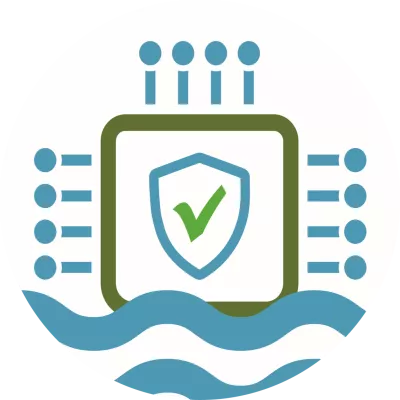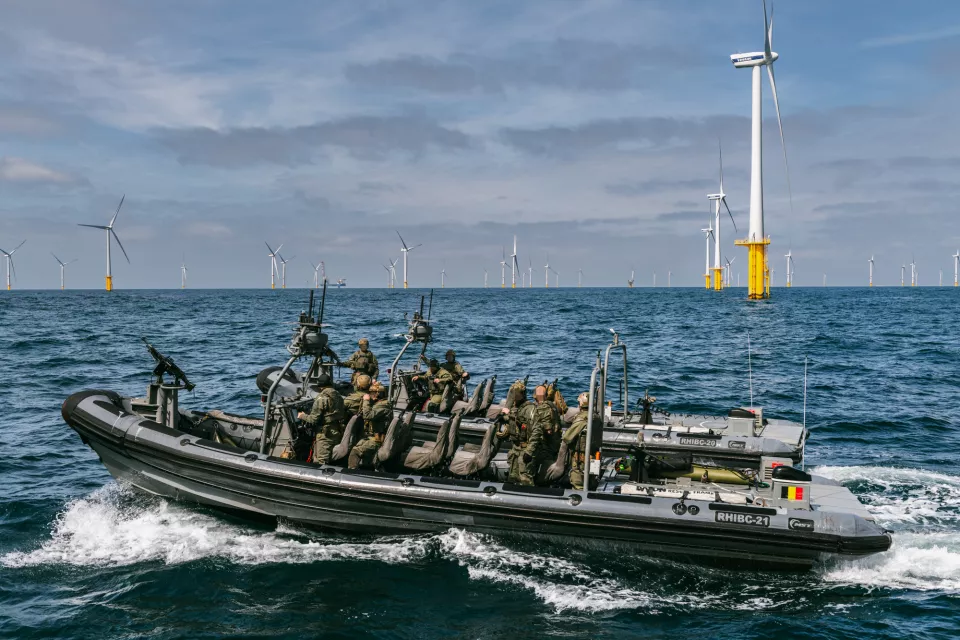Maritime security

A safe North Sea is of crucial importance to the Belgian and wider European economy. Ports play a key role in the import and export of goods. Offshore wind turbines account for a significant share of our power supply. In addition, there are thousands of kilometres of cables and pipelines on the seabed of the North Sea.
The current geopolitical tensions are one of the greatest challenges for the safety of our critical infrastructure at, on and in the sea. In order to better protect this maritime infrastructure, it is also important to stimulate cooperation and innovation around this theme.
Based on a great deal of input from industry, government and knowledge institutions, a number of priorities were determined. These are built around three central pillars: deter, detect & identify and respond.
Deterrence
Deterrence plays a crucial role in maritime security and is essential to ensure the safety of systems and infrastructure. The aim is to deter unauthorised access and prevent potential intruders from carrying out malicious activities. This can be achieved at various levels:
- Physical access: this involves physical barriers, such as fences and security systems, which discourage unauthorised individuals from attempting to gain access to sensitive areas and systems;
- Cyber access: this involves setting up resilient IT and OT infrastructure to prevent cyberattacks and other illegal activities. Such measures also help to minimise the impact of any breaches;
- Data access: the focus here is on protecting sensitive data and confidential information. Robust security measures such as encryption and access control can significantly reduce the risk of data loss or theft.
In short, deterrence is a fundamental aspect of maritime security that helps to protect both physical and digital assets. By implementing a combination of physical, cyber and data security strategies, organisations can create a secure environment that deters unauthorized access and ensures the integrity of their systems and information.
Detection & identification
Detection and identification are essential components of maritime security, especially as threats to offshore infrastructure and ports become increasingly complex. Being able to detect suspicious patterns or anomalies is crucial to prevent potential risks from developing into serious incidents.
One of the most important aspects of detection is the continuous monitoring of the environment around offshore infrastructure and ports using advanced technologies and sensors. This monitoring allows security teams to quickly respond to suspicious activity and thus reduce the likelihood of incidents.
Identification plays an equally important role in this process. By thoroughly analysing data from real-time monitoring systems, security professionals can quickly and accurately determine the nature of a threat. This results in informed decisions and targeted actions that benefit overall safety.

Other important benefits of a good detection and identification system include a reduction in the number of false positives and a reduction in response time. This is crucial in situations where every second counts and a quick response can save lives or prevent damage.
Finally, the rapid dissemination of alerts and information is essential. Effective communication ensures that all stakeholders are aware of potential threats and can act quickly. In this way, organisations can develop a robust maritime security strategy that not only promotes detection and identification, but also ensures the overall safety of their operations.
Response
The importance of rapid and effective response in maritime security cannot be overemphasized. In an environment where threats are constantly evolving, it is crucial to keep the time between detection and response as short as possible. Once a security breach is detected, appropriate and rapid action must be taken to limit the impact and prevent further damage.
Effective handling of security incidents is essential. This means that teams must be well prepared to manage incidents, with the right resources and knowledge to get the situation under control. A well-organised response can not only limit the damage, but also ensure the safety of personnel and infrastructure.
In addition, it is essential that there is a coordinated approach and good cooperation between all parties involved. A joint effort ensures that all parties involved in an incident can respond effectively and that the right resources are quickly available. This not only strengthens the response capacity, but also promotes the overall safety of the maritime environment.
Finally, evaluating and following up on incidents and actions is crucial to improving the resilience of maritime security. By learning from past incidents and analysing their effectiveness, organizations can continuously improve their procedures and strategies. This ensures that they are better prepared for future threats and that the security of maritime infrastructure and operations is continuously strengthened.